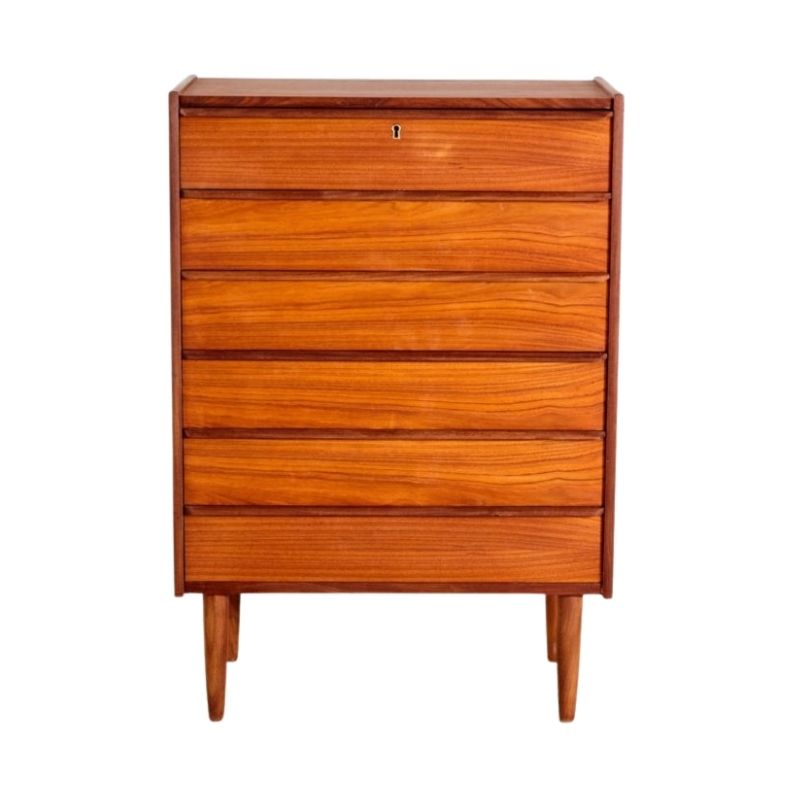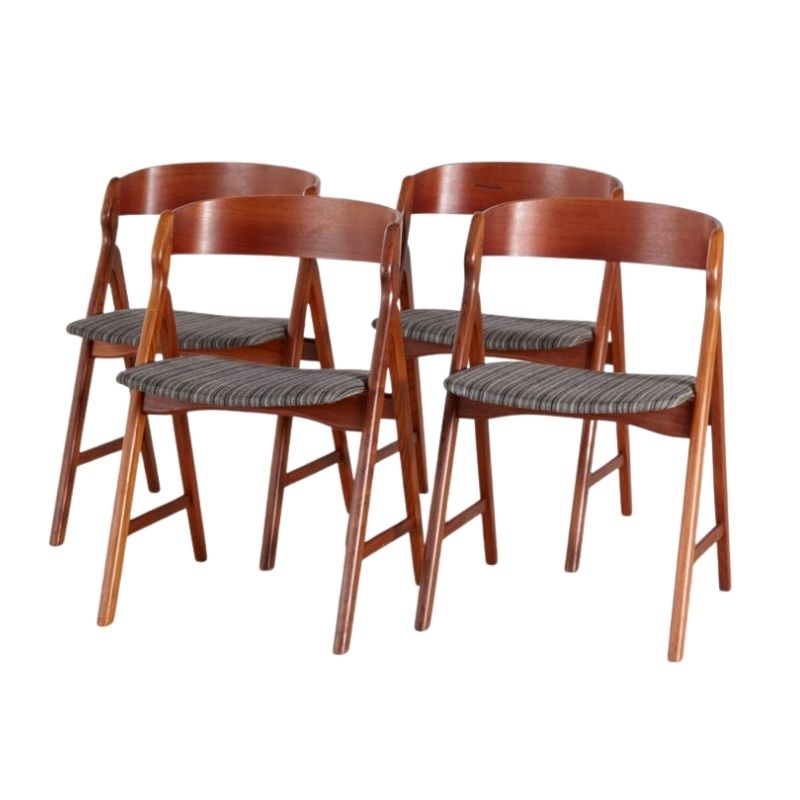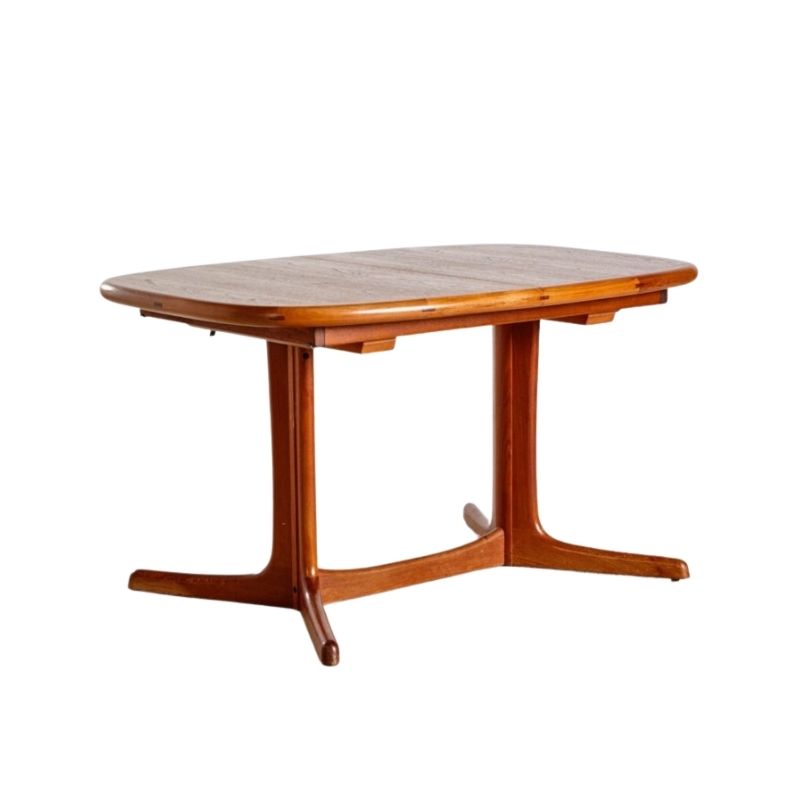Hi there friends,
I just acquired this nice France & Sons rocker and need to replace the interior foam on the back rest. As you can see the seat cushion was previously replaced with foam, but the back cushion still has the spring interior. When I initially opened it up, the old foam disintegrated to orange dust and there was a bit of cotton around the outside.
Question #1: How to re-wrap the springs? What materials to use? I don't want to inadvertently overstuff and lose the nice lines, but also need it to be comfortable.
Question #2: Any advice on cleaning the original fabric? I did a few rounds of hot water & dish soap which helped get out a LOT of staining but as you can kind of see, it is still dingy in some areas. I'm ready to accept them as is....unless anyone has a great solution for me to try?
Thanks in advance!  <img class="wpforo-default-image
<img class="wpforo-default-image
Put new cotton in just like the old, and then there is a layer of perhaps 1 inch foam that gets folded around the spring assembly, fold edge at the front of the spring assembly. The edges of foam get sprayed with foam glue and butted together all the way around. They never seem to stick together overly well when I do it. Nor did they stick together overly well when the factory did it.
Puttong the interior into the cushion is the hardest part. And it should be very, very tight. The folded foam edge goes first.
If 1 inch foam will not make a very tight fit, then you will need thicker foam.
First, have you measured the cushion covers since you washed and dried them? A lot of upholstery fabric isn't made to be washed, especially not in hot water. Yours are probably all wool, which is ok in cold water with no agitation, but it can shrink in hot water. They might be ok, though. A tape measure will tell you if they still match up to the dimensions of the spring unit.
I've redone a few of those spring units. Mine had 1/2" to 1" latex foam covering them---cut a panel to cover each of the six sides and glue it to itself at the seams. You can determine the appropriate thickness simply by measuring the sides of the cushion covers. The foam will be somewhat compressed when you put the covers on---they should fit snugly---but not squished down a LOT. Of course if the fabric has shrunk signficantly from washing, measuring won't help much. (Measure in all directtions, too---fabric usually shrinks more in length than in width. Usually. Not always. Fingers crossed!)
When covering the box unit with the foam, cut the side panels first and stick them to the unit using the spray adhesive. (They don't have to be super secure.) Then cut the top and bottom panels to cover the unit PLUS the edges of the foam sides.
Now for the cotton wrap on the foam. When you sit on a cushion, you invariably slide forward or back a little bit. This drags the fabric along the foam. A lot of fabric will grip foam and not slide back into place when you get up. Eventually the cushion cover will kind of rotate around the cushion---or worse, it will form unsightly creases that can't be smoothed out. SO, what you do is wrap the foam in batting. They used to use cotton batting, because that's all they had. While it has some great properties and is still the best thing in certain applications, it does break down as a cushion wrap. Nowadays there is bonded polyester upholstering batting (do not ever use quilt batting! it's way too wimpy). Poly batting provides a non-grippy surface for the fabric to slide back and forth on, and because it's bonded it doesn't disintegrate over time. You do have to glue it securely to the entire surface of the foam with heavy duty spray adhesive. 3M Heavy Duty is the best that is easily obtainable (big box hardware/lumber stores usually carry it, as do the big chain craft/fabric stores). Don't go for the cheaper brands; they do not hold up, something I know from experience.
Tip: thinner upholstery batting is harder to find, but the 3/4" stuff can be split into two layers pretty easily. I do this for most cushions to avoid that poufy, overstuffed look that is all wrong on MCM furniture.
I recommend latex foam over urethane for the back. You could get away with urethane on metal springs if you could use thicker foam, but 1/2" or so will get permanently compressed pretty quickly where it is squished against the metal spring edge, especially. Latex foam is a lot more resilient and holds up much better over time than urethane foam. It also costs more but you don't need a lot.
Oh, and the fabric covers---if they haven't shrunk, try an overnight soak in COLD water with Dawn dishwashing detergent. Use the clear variety, not the green or blue. (I spot treated some stains on wool fabric once with the blue variety and ended up with permanent blue stains on the fabric.) Use a very strong concentration. Rinse well in cold water and lay flat to air dry. A fan will speed up the drying but don't use heat. The sun could fade the color so don't dry them outside, either.
Let us know how it goes!
Wow, this is phenomenal. Thank you leif ericson and spanky!!!
Just a few questions to make sure I'm understanding correctly...the layers should be (from interior to exterior):
1 - spring unit
2 - cotton batting
3 - latex foam cut and glued with spray adhesive
4 - bonded polyester upholstering batting, adhered with spray adhesive
Is the latex around the springs the thick, dense stuff that you cut square around the box - or do you use the long sheets of more flexible stuff to make the "envelope? I guess it depends on how much room I have.
Where do you normally order your foam from? Hoping I can find what I need at a local craft store so I can get started this weekend.
Fingers crossed that the covers didn't shrink - I'll measure them tonight! Thank you both again for the amazing advice - gives me relief to know that I'm not going to royally screw this up! Maybe just a little 🙂
I've owned 2 of these sofas, both with original cushions. And in both cases, the foam was urethane. And there is no batting around the outside.
It is sometimes a hard call for me when it could be better than how it was manufactured. So your call.
You will have to measure the foam once you have done the cotton batting. Wrap a flexible fabric measuring tape around the spring assembly, starting at the center back (where the zipper will be) and going around the front to your starting point. That will be the length of the foam. The for the width of the foam: start at the center of a side and measure up over the top and down to the center of the opposite side.
You can buy latex foam as a mattress topper much more cheaply than as a custom cut piece.
Leif was writing his reply as I was writing mine. The cushions I redid did not have any cotton around the springs. The kind of cotton batting I've seen in old Danish furniture was a thin, bonded mat type, like 1/4" thick at most, that looked almost like a cotton blanket except not woven. I've never seen it available anywhere now but maybe there are sources I don't know about. If you're a total purist about restoration, then you might want to try to find it.
The type of cotton batting that is still made is a very thick type that can be separated into layers, though it's a little tricky to keep the thickness uniform. It's really just unbleached cotton fiber (with a fair amount of plant matter included!) pressed into a thick mat form. It's great for padding sharp edges and corners of wood frames where you don't need much resilience, to keep the fabric protected from the frame so that it doesn't wear off. But I think on moving parts---such as springs that compress and uncompress with every move of the human body---it's not too effective over time. But before polyester was invented they didn't have a lot of other options.
There are some kinds of thin, very dense polyester battings that may work, especially if you bond them yourself to a layer of synthetic non-woven material using spray adhesive. The point, I assume, is to protect the foam from wearing against the metal springs. I don't have any problem upgrading to more modern, better-performing materials where they won't show at all in the finished chair. (I cannot abide good mid-century modern furniture redone in fabrics that aren't appropriate to the era, though! GAH.)
Anyway, the foam. The stuff sold in craft stores is garbage. It is usually described as high-density but is actually very low density. I know Joann's used to see both "regular" and "high" density; the regular was not much more than bubble bath suds!
Even buying from an upholstery supply place can be confusing, though--the stuff they get in 50' rolls is usually lower density. I have to buy the 104" long sheets to get higher density foam, which my local place offers in a couple of densities. But one of those is plenty for your needs anyway.
If you don't have access to an upholstery supply store, you should get it online. If you want latex foam, you'll pretty much have to get it online unless you happen to live near one of the very few places that sell it in the US. But since you only need a thin layer, you can probably do ok with a mattress topper. See if you can find one that doesn't have the holes all the way through it.
Cut individual pieces for each of the six surfaces of the spring unit. If you wrap it, you'll end up with rounded edges and the foam will also start out compressed. You want as much padding as possible on the wire while still keeping a fairly trim look.
The poly batting that I spoke of in my first response goes around the foam.
Leif, what kind of spray adhesive do you use? I started using Misty brand a few years ago and haven't tried 3M Heavy Duty since---maybe Misty is better? It just happened to be the brand my local place carries and it's $5-ish/can when bought by the case, so I went with it. It holds really, really well. Like, you had better position everything just right before sticking the two surfaces together, because they will NOT come apart again without the foam ripping apart. (Well, maybe if you do it immediately. If the glue was still pretty wet when you pressed them together.) I've never seen it in the big box or craft stores but it's available on Amazon by the case and from other online dealers.
Ah...well, give 3M Heavy Duty a try, or Misty if you can use a case (or maybe you can find it sold individually). I think it's essentially contact cement in spray form.
emsy--I forgot to say that when you use spray adhesive you should do it outdoors if possible, or at least in a very well ventilated room--and use a respirator if you have one. If you don't have a respirator, at least hold your breath while spraying and then back away for some fresh air before continuing. Also, wear disposable gloves. Even when you are careful, you will get it on your fingers as you stick the parts together and then all the poly fibers stick to you and you have to spend 15 minutes rubbing it off with vegetable oil, or use Goof-Off or acetone directly on your skin. It's easier to just use gloves!
Aah ok now I have a better picture of it, thanks again!
So I've been looking around for foam and it doesn't seem too easy to find - the stuff at Joann's looked pretty poor and they weren't helpful. There are a few stores I'm going to try over the weekend. As a back up plan, would something like this suffice?
https://www.amazon.com/gp/product/B009ZINRG2/ref=ox_sc_act_title_2?ie=UT...
Great tip @ using gloves spanky!
emsy84,
Spanky is very correct in the use of 3M* spray adhesive. You may obtain a MSDS from the manufacturer. A respirator as opposed to a pollen mask is a must.
I contract "outside" sources to clean vintage or delicate fabrics. Cleaners qualified to refresh and maintain couture clothing are the best bet. I also use the same vendor for vintage US flags.
*3M has no equal in cyanoacrylates, epoxies and spray adhesives. They also have excellent technical assistance. Small quantities may be difficult to purchase from distributors (no broken cases).
I'm kind of leery of buying this kind of thing on Amazon because who knows what they're comparing it to when they say it's firm, or whatever. It's all so relative. Look at foamorder.com's breakdown of the different foams they sell---way more information!
http://www.foamorder.com/upholstery-foam.php#rebond
I don't know that you need their most dense foam, since it's only 1" thick and it's going over springs, but at least you'll have more choices. They used to have a description of how density and resilience are measured ---might still, I haven't looked since they redid the site.
I would seriously consider their latex foam mattress topper in the softest density, though---you don't want your back cushion to end up feeling as firm (or firmer!) than the seat. If you use exactly the same density material in seat and back cushion, the back will always feel too firm (or the seat too soft, either way). Since your seat foam is kind of an unknown, and the back springs are kind of an unknown too, I'd err on the side of soft. Even soft latex will hold up better than urethane foam over time.
http://www.foamorder.com/latex-mattress-topper.html
You can get away with a twin size since it's only the back cushion.
As mentioned earlier, Home Depot, Lowe's, Joann Fabrics and other stores stock 3M Heavy Duty Spray Adhesive. No problem getting single cans! They are overpriced, though--but the craft stores regularly have coupons that make the 3M in line price-wise with brands that are equal or better in quality, like Misty. (And no, I don't own stock in Amcor/Misty! I've just gone through several cases of it and have dealt with trying to undo the bond that it creates---forced me to incorporate careful positioning in my upholstery gluing process! Good times...)
Apropos of the question of density of latex foam and durability. I don't think that the density of latex foam can be changed. Therefore, the manufacturer molds it with varying size holes to modify the density. (Hence it is sometimes called pincore).
Hence, I suspect the durability of latex is not greatly changed by the changing density rating. The only thing that might make less dense latex less durable is the slightly greater surface area exposed to the air.
You are quite right--that's how they control the density, with the air holes. I do wish there were some stats on how long latex lasts before it starts to harden and crumble. Of course there are environmental factors like the amount of air circulation and the temperature, I guess--but still. Though I guess a lot of latex mattresses have a 25 year guarantee---so maybe dryness doesn't start until at least then?? I don't know.
Anyway, even firm density urethane foam develops hollows in way less time than that. I would use nothing but latex foam if I could.
Not to sidetrack the conversation, but this talk about latex vs polyurethane made me wonder about memory foam, which is a form of polyurethane, but with additional chemicals that seems to me to make it fairly similar to latex (similar density though less bouncy). Could memory foam be used for chair cushions, has anyone tried it, or is not an appropriate material?
If you need any help, please contact us at – info@designaddict.com









